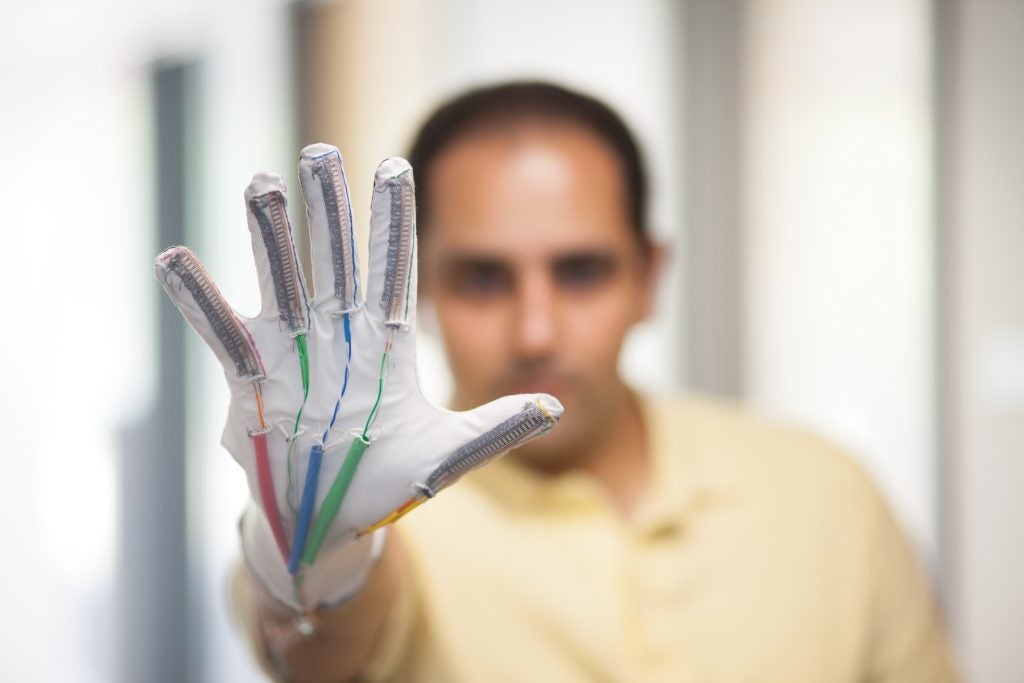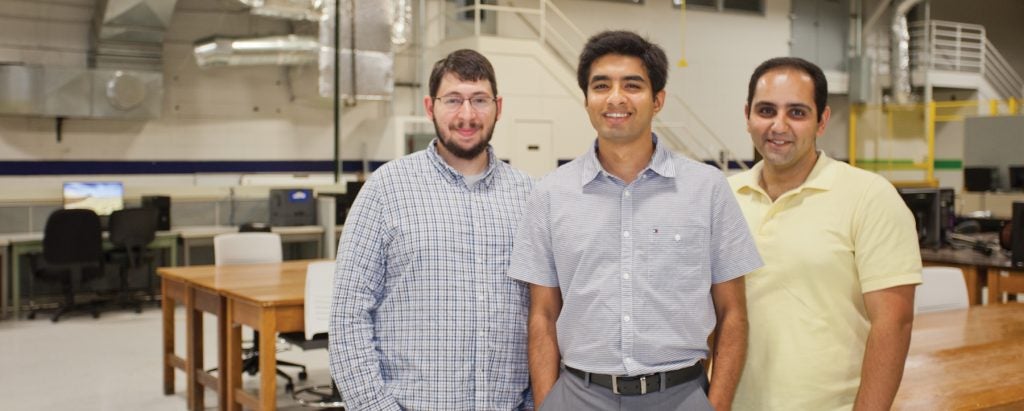Kunal Mankodiya, is creating textiles much different than the ones he helped his family sell as a child in India. Today, Mankodiya designs smart wearable systems.
Mankodiya, assistant professor of electrical, computer and biomedical engineering, strives to meet crucial problems in the healthcare industry – among them, long-term monitoring and data synthesis – with affordable, applicable solutions, his smart textiles.
Mankodiya’s Wearable Biosensing Lab at URI is working to create wearable systems, such as smart clothes and socks, which can mimic the technology found in hospitals and patient homes. Discreetly woven with an array of sensors, the smart clothes can non-invasively track important patient metrics such as heart rate vital signs, physical activity, falling, walking or other movement difficulties in their daily life.
“There is a huge demand for doing data collection at home,” Mankodiya says. “Hospital devices cannot translate to home because they’re not made for home monitoring.”
This day-to-day tracking is particularly important, Mankodiya says, for patients who had strokes or heart attacks. The textiles gather data on movements and analytics. Mankodiya’s lab has also created gloves that can monitor symptoms of patients with Parkinson’s disease, and socks that can monitor movement.
“The sky is the limit, but we want to design what will be appropriate,” he says.
The devices would not only enable doctors to monitor patients’ symptoms remotely, but also allow care to be given with a more in-depth understanding of the patient’s history.
“The idea is we can use smart textiles to collect that data, and the data provides a window for medical professionals to see their patients progress,” Mankodiya says. “It’s important to look at their progress over time. Doctors are unable to see it on a daily basis, so we are trying to bridge this gap in health care.”
The Internet of Things
Mankodiya’s interest in the intersection of smart textiles and the internet led him to another of his substantial research projects: The Internet of Things (IoT).
Lacking any means for home analysis of the data collected by smart textiles, patients still rely on visits to medical professionals to translate the information collected by their smart textile devices. However, with Mankodiya’s IoT, data gathered by the smart textiles is sent to the cloud where it can be accessed for diagnostics by health care providers.
The IoT blends Mankodiya’s smart textile technology with cloud computing to collect data that enables personalized, dynamic health care. One of the features he’s most excited about? Some preliminary data analysis can even be done on a patient’s mobile device.

One of Mankodiya’s preliminary tests of the intersection of wearable technology and the Internet of Things was a research study done with Rhode Island Hospital. Smart watches were given to patients at risk of post-traumatic stress disorder (PTSD) and used to track patient behavior over time. This project allows clinical experts to see how their patients are behaving before and after the behavioral treatments. The aim is to adjust the treatments on-the-go with a promise to reduce the time associated with trial-and-error.
Not only does the technology allow health care providers to track the onset of symptoms, but the longevity of the data allows them to track behavior patterns. “We’ll be able to track from the watch sensors why some episodes happen at a particular time of the day,” Mankodiya says of PTSD episodes.
A Diversity of Perspective
Mankodiya has been recognized locally and internationally for his work as a scientist. In 2017 he was awarded a National Science Foundation (NSF) CAREER award and a URI Early Career Faculty Research and Scholarship Excellence award. He was also named Future Textile Awards “Innovator of the Year” Frankfurt, Germany, and is one of the Providence Business News “40 under 40.”
Since coming to the University, his research has been funded by three NSF grants, one National Institutes of Health grant, and 16 foundation or local grants. Mankodiya has been awarded close to $1.8 million that supports six Ph.D. students, three master’s students, and several undergraduate students. His lab is a multi-cultural environment where diversity is a strong force for the innovation and development in cross-disciplinary domains.

In addition to his research, Mankodiya played a key role in establishing the Rhode Island Textile Innovation Network, a collaboration among the state, manufacturers and textile industry leaders that seeks to maximize use of the state’s manufacturing infrastructure and foster innovation and growth in Rhode Island’s textile industry.
The Rhode Island Textile Innovation Network is not the only professionally-diverse team Mankodiya works with. He has initiated many interdisciplinary research teams at URI to approach problems in health care from a broader breadth of knowledge.
“This diversity of perspective,” he says, “creates innovation.”
Watch Kunal Mankodiya’s TEDx talk
Watch Video
Story originally printed in Momentum: Research & Innovation, a publication of the Vice President for Research and Economic Development, with editorial, graphic design and production by the Office of University Research External Relations.
